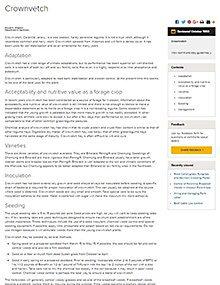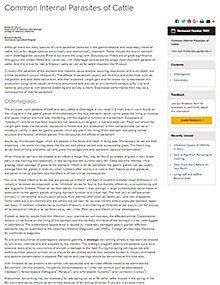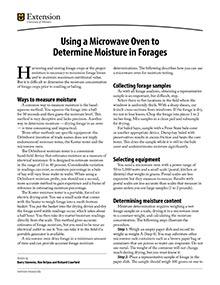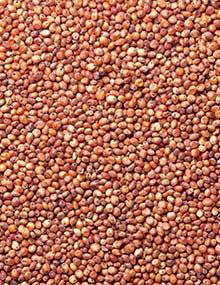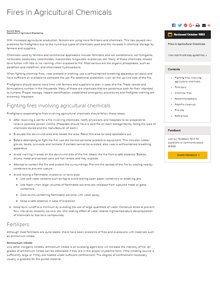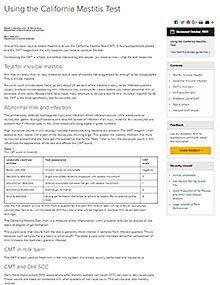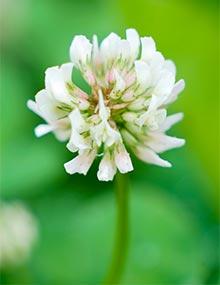Dehumidifiers
Reviewed
Dehumidifiers reduce the moisture in the air. They provide comfort for people and reduce or eliminate deterioration of equipment due to rust, rot, mold and mildew.
Sheep Pregnancy Checking by Ultrasonic Sound
Reviewed
Ultrasonic sound waves can be used to determine sheep pregnancy without harming the ewe or fetus. Learn how the procedure works and pregnancy is diagnosed in this University of Missouri Extension guide.
Selecting and Working With a Farm Building Contractor
Reviewed
Two major tasks are involved in the successful completion of a new farm building — choosing the right building and selecting a good contractor to build it.
Most buildings constructed today are "pre-engineered," or package-type, buildings.
Getting Problem Cows Pregnant
Reviewed
An average interval of 70 days from calving to first breeding and a high fertility rate are important to maximize efficiency in dairy herds. The results are more milk and calves at reduced cost.
Crownvetch
Reviewed
Crownvetch, Coronilla varia L., is a cool season, hardy, perennial legume. It is not a true vetch, although it resembles common and hairy vetch. Crownvetch spreads from rhizomes and will form a dense cover. It has been used for soil stabilization and as an ornamental for many years.
Common Internal Parasites of Cattle
Reviewed
Preparing for an Emergency: Home Heating in an Emergency
Reviewed
At some time you may face a heating emergency. Visit our site for our Preparing for an Emergency: Home Heating in an Emergency guide.
How to Build a Compost Bin
Reviewed
Learn about five types of composting and how to build a composting bin. Worm and hemp composting, wire-mesh and snow-fence holding units, and wood and wire three-bin turning units are all covered in this University of Missouri Extension guide.
Home Slaughtering and Processing of Beef
Reviewed
A beef animal selected for slaughter should be healthy and in thrifty condition. Visit our site to learn about home slaughtering and processing of beef.
Feeding to Maximize Milk Solids
Reviewed
Using a Microwave Oven to Determine Moisture in Forages
Reviewed
Harvesting and storing forage crops at the proper moisture is necessary to minimize forage losses and to maintain maximum nutritional value. But it is difficult to determine the moisture concentration of forage crops prior to ensiling or baling.
Kitchens for Workers in Wheelchairs
Reviewed
Space for the wheelchair, plus space for turning the chair are the two important factors to consider when planning a new kitchen, remodeling a structure or adapting one being used.
The standard model wheelchair (measurements taken from American Standard specifications) falls within the following limits:
Household Hazardous Products
Reviewed
A household hazardous product is one whose use or disposal poses a threat to human health or the environment. Hazardous products should not be put in the trash, down the drain, into storm drains or burned unless you are instructed to do so by local waste authorities.
Low-Profile Bins for Grain Drying
Reviewed
Wheat Silage for Dairy Cattle
Reviewed
Corn Silage
Reviewed
Corn silage is a popular forage for ruminant animals because it is high in energy and digestibility. Visit our site to learn more about corn silage.
Simple Home Repairs: Wood Porch Flooring
Reviewed
Wood porches are beautiful, but sometimes boards or planks break or splinter, making them unsafe. Using the following instructions, they can be repaired.

Barley
Reviewed
Winter and spring barleys are available, but testing in Missouri indicates spring barley does poorly. Plus, six-row barleys have higher yield potential than two-row barleys in Missouri. Therefore, this publication covers only the six-row winter barleys.
The Bluegrasses
Reviewed
Fires in Agricultural Chemicals
Reviewed
With increased agricultural production, farmers are using more fertilizers and chemicals. This has caused new problems for firefighters due to the numerous types of chemicals used and the increase in chemical storage by farmers and suppliers.
Estimating Peak Rates of Runoff From Small Watersheds
Reviewed
Use the following equation to estimate the peak rates of runoff to be expected from watersheds smaller than 200 acres in Missouri:
Q = QT x L x I x T x S x V x C x P x F where
Q = Peak rate of runoff, cubic feet per second.
Using the California Mastitis Test
Reviewed
One of the best ways to detect mastitis is by using the California Mastitis Test. Visit our website today to learn more.
White, Ladino and Sweet Clover
Reviewed
White and ladino cloverWhite clover is a stoloniferous plant with a shallow root system. The primary stems of white clover usually die before the second year, and the life of the plant depends upon the stolons and their haphazard roots.

